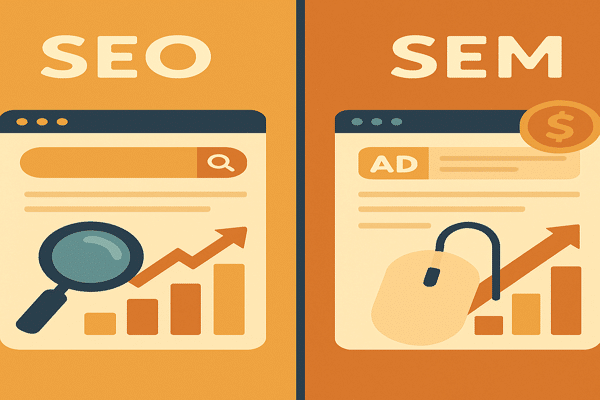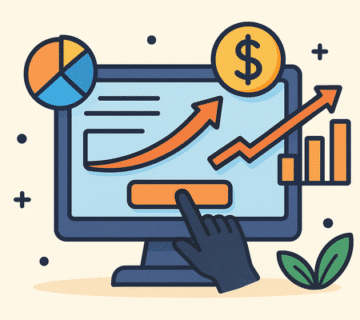The Difference Between SEO and SEM
Introduction
Today’s world is undergoing massive transformations in marketing, where digital marketing strategies have become essential for every business. Digital marketing allows companies to reach a wide audience in cost-effective ways, enhancing digital presence and increasing sales. Within this transformation, two core concepts stand out: Search Engine Optimization (SEO) and Search Engine Marketing (SEM). Understanding these concepts is the cornerstone of any successful marketing strategy.

SEO focuses on improving a website’s visibility in organic search engine results. This involves understanding search engine algorithms and optimizing both content and technical aspects of a website. On the other hand, SEM centers around using paid advertising to attract customers, enabling companies to appear instantly in search results through sponsored listings.
Knowing the difference between SEO and SEM helps businesses make informed decisions about their digital marketing strategies. While SEO is a long-term investment for sustainable results, SEM can deliver quick, immediate visibility. As technology plays a growing role in our daily lives, the ability to stand out digitally is key to success. Marketers must be fully aware of how to use both SEO and SEM effectively to maximize their marketing campaigns.
What is SEO?
Search Engine Optimization (SEO) is the practice of enhancing a website’s visibility in organic search engine results such as Google, Bing, and Yahoo. SEO strategies rely on understanding how search engine algorithms work and implementing tactics that align with them. The goal is to attract visitors naturally, without paying for ads.
Key elements of SEO include keyword research, content optimization, and link building. Keyword selection is crucial—marketers must analyze what terms their audience is searching for and use them organically within website content. Proper keyword use increases the chances of ranking higher in search results.
Content optimization involves creating high-quality, relevant content that adds value for users. Search engines prioritize content that is useful and engaging. Including visual elements like images, charts, and videos can enhance user experience and keep visitors on the page longer.
Link building refers to acquiring backlinks from other reputable websites. These links signal trustworthiness to search engines and improve search rankings. In summary, SEO is a continuous process requiring ongoing analysis and adjustments in response to algorithm updates and user behavior changes.
What is SEM?
Search Engine Marketing (SEM) is a vital digital marketing strategy aimed at increasing visibility in search engine results through paid advertising. Marketers use platforms like Google Ads and Bing Ads to target specific audiences by bidding on keywords related to their business. These ads drive traffic to websites and increase brand awareness.
Unlike SEO, which focuses on organic traffic, SEM delivers fast results through financial investment. Advertisers compete for ad placements, with rankings influenced by factors like ad quality and bid amounts. This makes SEM an effective approach for companies looking to see immediate results.
SEM also provides valuable data on consumer behavior and preferences, allowing marketers to refine their messaging and targeting. Paid strategies like Pay-Per-Click (PPC) are cost-effective in driving leads and conversions in the short term.
Key Differences Between SEO and SEM
Understanding the distinctions between SEO and SEM is critical for developing effective digital marketing strategies. SEO involves techniques to improve organic rankings without direct costs per click, whereas SEM requires financial investment for paid traffic.
One major difference is cost—SEO is more affordable long-term but takes months to yield results. SEM, however, produces immediate visibility once campaigns are launched.
Their goals also differ: SEO improves site quality and user experience to gain organic traffic, while SEM targets broader audiences with ads for faster conversion. Using both in tandem offers balance—SEO builds long-term authority, while SEM boosts instant exposure and lead generation.
The Importance of SEO in Digital Marketing
SEO is essential for achieving long-term success in digital marketing. It provides a sustainable way to generate organic website traffic by ranking higher in search results. Unlike paid ads, SEO offers lasting results, making it a wise investment.
SEO enhances user experience by delivering relevant, quality content tailored to user interests. Improved site usability and engagement lower bounce rates and boost rankings.
Moreover, high search rankings build trust. Consumers often associate top results with credibility, increasing conversions from organic traffic. SEO isn’t just a technical tool—it’s a strategic discipline requiring patience, creativity, and continuous optimization.
The Importance of SEM in Digital Marketing
SEM is increasingly vital in digital marketing, enabling rapid audience reach and brand visibility through paid campaigns. Platforms like Google Ads allow businesses to bid on keywords, direct targeted traffic to their sites, and collect insights on user behavior.
Campaigns can focus on brand awareness, sales, or lead generation through various ad types, including search, display, and social ads. This diversity helps businesses choose the best channels for their goals.
Success in SEM depends on metrics like click-through rate (CTR), conversion rate, and cost per acquisition (CPA). Analyzing these metrics helps improve campaign efficiency and allocate budgets wisely. Ultimately, SEM is crucial for businesses aiming to stand out in competitive digital markets.
Successful SEO Strategies
SEO strategies are foundational to digital marketing. One key tactic is keyword research, using tools like Google Keyword Planner to find high-volume, low-competition search terms.
On-page SEO focuses on optimizing titles, descriptions, and internal linking. Proper use of H1 and H2 tags, meta descriptions, and clear URL structures boosts site performance.
Off-page SEO involves backlinking—earning links from trusted external sites to increase domain authority. Quality backlinks improve a site’s credibility and rankings.
Ongoing analysis is crucial. Tools like Google Analytics help track traffic, bounce rates, and conversions, enabling data-driven improvements.
Successful SEM Strategies
Effective SEM strategies start with careful keyword research. Understanding user behavior helps identify search phrases with high potential. Analytics tools assist in evaluating keyword volume and competition.
Ad copy is equally important. Ads should be compelling, relevant to keywords, and include calls-to-action. Regular A/B testing ensures continual refinement based on performance.
Data analysis is key to ROI optimization. Tracking metrics like CTR and CPA reveals what works, guiding campaign adjustments. Integrating SEM with SEO also enhances performance by aligning content and technical efforts.
Conclusion
SEO and SEM are critical tools for boosting digital visibility and business success. While both aim to improve online presence, they differ in approach—SEO focuses on long-term growth through organic optimization, whereas SEM delivers fast results via paid campaigns.
Each has unique advantages. SEO builds credibility and sustainable traffic, while SEM accelerates lead generation and conversions. Marketers should consider combining both to maximize impact—leveraging SEM data to enhance SEO content.
A balanced strategy using SEO and SEM ensures strong digital positioning, helping brands grow and compete effectively in an ever-evolving digital landscape.




A brilliant intersection of tech and strategy — optimizing speed gives your site a clear edge in search rankings.